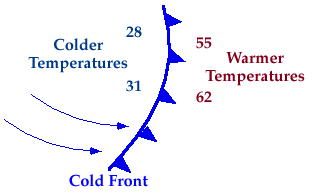
|
A cold front is defined as the transition zone where a cold air mass is replacing a warmer air mass. In the example below, temperatures ahead of the cold front are 55 and 62 degrees while behind the front, the temperatures are lower, 31 and 28.

The air mass behind a cold front is likely to be cooler and drier than the one before the front. If a cold front is approaching, precipitation is possible just before and while the front passes. Behind the front, expect clearing skies, cooler temperatures, and lower relative humdities.
|
